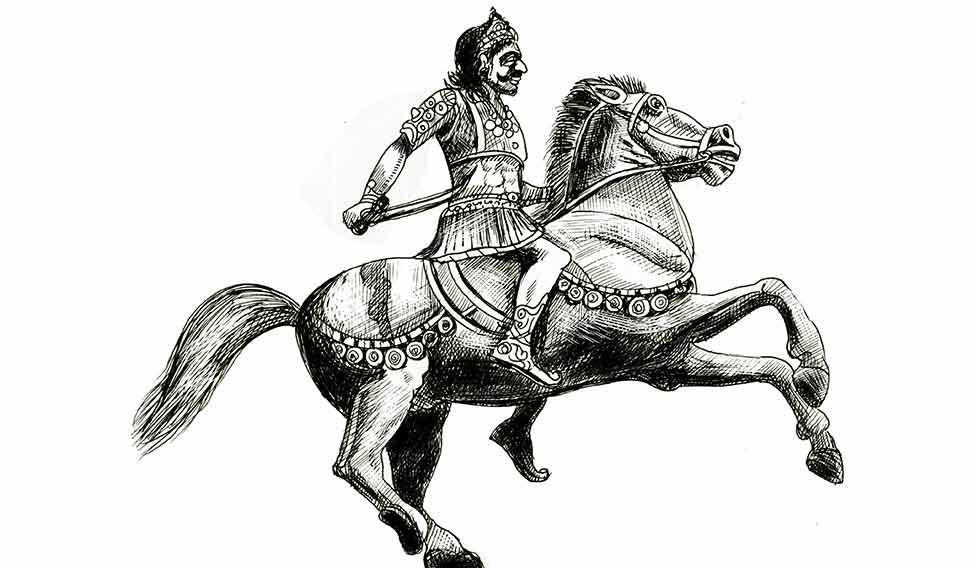
One of the most popular attractions in the 12th century Qutub complex in Delhi is the iron pillar that never corrodes. Owing to popular mythmaking, it has come to be associated with many legends. Originally belonging to another location and from another time in history, this pillar, nevertheless, holds academic significance. An inscription on its body speaks of the valour and victories of a certain 'Candra' who conquered the ‘Vahlikas’ and the ‘Vanga’ countries. It narrates a battle ‘across the seven mouths of the River Sindhu’ and of the ‘spread of his fame up to the Southern Seas’.
One group of scholars believes it is a reference to the Gupta monarch Chandragupta II, who ruled from 375 to 414 CE and was responsible for defeating the Saka satrapas based in western Malwa and Saurashtra. This is recognised as the biggest achievement of the Gupta monarch, wherein through political conquests and marriage alliances, he was able to extend the Gupta empire to the edges of western India. These are irrefutable facts about the historical figure, supported by numismatic, literary and inscriptional evidences. The king issued coins in the conquered territory calling himself ‘Sakari’—enemy of the Sakas.
What is mysterious, however, is the royal epithet that Chandragupta II assumed for himself soon after his conquest: Vikramaditya.
The term ‘Vikramaditya’ has been in parlance since the Vedic times, associated with many sun myths and Puranic tales. As a certain group of scholars opines, it has been used by royalty as an epithet from the middle of the 1st century BCE onward. This theory assumes the authenticity of a historical ruler of Malwa called Vikramaditya, who flourished in the middle of 1st century BCE and established the Vikrama era in 58-56 BCE.
There is hardly any conclusive proof to show that Chandragupta II was the first emperor to assume this title. Practically the entire Gupta dynasty assumed the epithet, and in popular mind, the glory of the historical Vikramaditya got connected with the splendour of the Guptas, thus leading to an association of Chandragupta II with the legends of the Vikrama tradition. It is probable that the historical Vikramaditya (if he existed) held in himself the qualities of an ideal king which every successive monarch tried to emulate. From Bhoja of Dhara to Kumarapala of Gujarat to the illustrious Gupta rulers like Samudragupta, Chandragupta II and Skandagupta—all used the epithet.
What makes it impossible to reach a sound conclusion is the fact that lamentably little is known about the Gupta rulers’ individual histories. It is proven that the dynasty that dominated Indian history from the 4th to 5th centuries brought about a cultural Renaissance and strengthened the political, economic and commercial position of the country. However, in the absence of personal histories and the lack of corroborative evidence, the ‘Vikramaditya’ problem persists.
So the mystery of Chandragupta II and his epithet continues, while historians struggle with the available evidence and whether or not to assign these to the Gupta monarch. Could it be possible that the Gupta rulers took on the epithet continuing an age-old tradition of a symbolical association with an ideal king?
Did a historical Vikramaditya exist, and if so, was it him that these Gupta rulers were trying to emulate?
Could it also be possible that the legend of ‘Vikramaditya’ that stays in popular imagination today be nothing more than the ‘idea’ of a perfect king, rather than a historical figure?
As questions like these continue to trouble as well fascinate historians and laymen alike, it must not be forgotten that the historical Chandragupta II was an illustrious ruler himself. Belonging to an age called the ‘The Golden Age’ of Indian history (a problematic term in itself), he persevered and strove towards continuing the legacy of his ancestors. He patronised art and architecture, contributed to making the empire politically and administratively stronger, and adopted an attitude of religious tolerance. To vouch for this fact, the eyewitness account of the Chinese monk Faxian survives. Travelling across Madhyadesa in the 5th century CE, he writes of a land of peace and plenty. Here, too, the mystery of the ruling monarch stays unresolved because the author does not name him. It is generally agreed that the account is contemporaneous to the time of Chandragupta II. There is also the legend of the nine gems that Chandragupta II patronised, Kalidasa and Varahamihira being two of them.
Finding a solution to the Vikramaditya problem might take many more years. However, the Vikrama legend survives and continues to significantly impact popular imagination in India. Probably based on several illustrious rulers, probably in memory of an ‘original’ Vikramaditya, or probably pointing to Chandragupta II, it has completely woven itself into the fabric of Indian culture. As ruler after ruler took on the epithet and strove to create an ideal kingship, the legend grew and the tales continued. Even today, every Indian child grows up with the story of a valiant ruler, the angels on his throne and a tree-spirit that asks him questions.
Vikramaditya, whoever he was, lives on.
Shubhasree Purkayastha works in the outreach department, National Museum, New Delhi.





